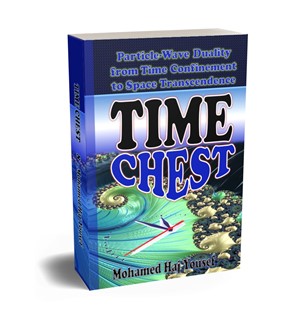Time Chest
 The purpose of this book is to explain the mystery of time in a modest language away from any complex mathematical formulation or hefty philosophical pondering. All the new conceptions about time and creation are extracted from the "Single Monad Model of the Cosmos" developed by the author, based on Ibn al-Arabi's theory of the "Oneness of Being". The details of this cosmological model, and all associated principles and consequences, have been published in three-volumes book series that described this revolutionary view of time and its philosophical and ontological foundations, comparing all that with the concluding results of modern scientific theories.
The purpose of this book is to explain the mystery of time in a modest language away from any complex mathematical formulation or hefty philosophical pondering. All the new conceptions about time and creation are extracted from the "Single Monad Model of the Cosmos" developed by the author, based on Ibn al-Arabi's theory of the "Oneness of Being". The details of this cosmological model, and all associated principles and consequences, have been published in three-volumes book series that described this revolutionary view of time and its philosophical and ontological foundations, comparing all that with the concluding results of modern scientific theories.
In the first volume, we introduced Ibn al-Arabi's eccentric conception of time and outlined the general aspects of his cosmological views. This fundamental insight was developed in the second volume into the Duality of Time Theory, which provided elegant solutions to many persisting problems in physics and cosmology, including the arrow-of-time, super-symmetry, matter-antimatter asymmetry, wave-particle duality, mass generation, homogeneity, and non-locality, in addition to deriving the principles of Special and General Relativity based on its granular complex-time geometry. The third volume explores how the apparent physical and metaphysical multiplicity is emerging from the absolute oneness of divine presence, descending through four fundamental levels of symmetry: ultimate, hyper, super and normal.
The current book is extracted and refined from these three volumes, to make it relevant and accessible to more readers who may be interested in the definitive conclusions, rather than any exhausting proofs. Passionate readers who require further, and more comprehensive arguments, are referred to the previous volumes inside the text, whenever some urging validation may be necessary.
The title of this book "Time Chest" is literal and intended for two different but complementary meanings: first because 'time' is a treasure chest that opens only when we comprehend its real meaning, and then we shall learn that our normal time is actually imaginary and that its real part is 'space' itself, which acts like the wave-front (that is the 'chest') of the outward time. Therefore, the Chest of Time is nothing but the physical vacuum, or empty space, that is indeed full of unimaginably huge amounts of energy, we usually call it 'dark' because we don't have access to it under our current theories!
This book is divided into five chapters, in addition to a prolonged introduction in which we summarize the Single Monad Model of the Cosmos, and the resulting Duality of Time Theory, so that we can investigate their important consequences and apply them in the coming chapters. In the first chapter we give a brief description of the various models of macroscopic physical phenomena, described by the standard theories of Classical Mechanics and Thermodynamics, focusing mainly on the essential role of "time", as well as "space", and the problems that arise from not realizing its unidirectional character.
Although Relativity is usually connected with astronomy and cosmology, all dealing with large-scale objects and heavy gravitational masses, we shall see that the main characteristic of the Theory of Relativity is connecting time with space and matter with energy, via the famous equation E=mc2, and thus connecting particles with waves long before this was investigated in Quantum Mechanics. Therefore, the second chapter is focused on the Theory of Relativity and Wave Phenomena, after introducing a fundamental correction that brings back the classical concept of the luminescent aether, in a manner that does not contradict the constancy and invariance of the speed of light. In this way, vacuum, or empty space, will be the physical medium that conducts the waves of light, and gravity will be naturally quantized because the new complex-time geometry is intrinsically granular. Therefore, Quantum Mechanics will be a natural, and \textbf{logical}, consequence of the new genuinely-complex geometry, as we shall investigate in Chapter Three. In fact, as such, and contrary to the common misunderstanding, Quantum Mechanics is the theory of particles, which are intrinsically quantized, and not waves, which are naturally continuous, although they usually manifest in quantized forms that are actually the particle behavior, as they are confined in the quantized outward time, of the actually continuous energy phenomena, or waves of the real inner part of time, since these particles transcend into space between each consecutive moments of the outward time.
With the previous fundamental correction, based on which the Quantum and Relativity theories will become complementary, Dark Energy and the Supernatural Phenomena will be explained based on the same complex-time geometry, thanks to the new orthogonal arrow of time, as we shall investigate in Chapter Four.
Finally, since now everything is explained in terms of geometry, we shall discuss in Chapter Five the Divine Origin of Geometry, which is dynamically being formed from, and broken into, the two orthogonal arrows of time, and as we shall explain in the Introduction: "God is the Time".
Based on the remarkable success of the genuinely-complex time-time geometry in reconciling Relativity and Quantum theories, and providing elegant solutions to many of the major persisting problems in physics and cosmology, the basic questions on the nature of time are addressed in this book in straight statements that explain our daily observations of natural and mystical phenomena, including both the visible and the invisible realms. Understanding time provides the sole key to crack all the three conclusive realms of the physical, psychical and spiritual worlds, that involve the human beings.
Accordingly, this book will provide direct and clear answers to the common questions such as:
* What really is time?
* Does it have a beginning, or an end?
* Can we stop time, or reverse it?
* What is the definite structure of time?
* Are space and time continuous or discrete?
* What is the definite relationship between time and space?
* What does the word "now" or "moment" mean?
* Why does time only move into the "past"?
* What is the reality of the "future"?
* Are the past and the future somehow existing somewhere?
* Is time-travel possible, to the past or to the future?
In addition to these common questions, many deeper scientific issues and major persisting problems are now easily explained based on the new complex-time geometry, including:
* Entropy and the arrow of time, or the second law of thermodynamics.
* The constancy and invariance of the speed of light.
* The wave-particle duality.
* Causality and non-locality.
* The Horizon Problem, or why the Universe is homogeneous?
* Dark matter and energy, or the Cosmological Constant problem, also known as the Vacuum Catastrophe.
* The Hierarchy Problem, or why the force of gravity is extremely weak?
* Parity breaking in weak interaction, or the CP violation.
* Quantum Gravity.
* Yang-Mills Existence and Mass Gap.
* Color confinement, or why Quarks cannot exist as individual particles.
The Duality of Time Theory, that results from the Single Monad Model, explains how multiplicity is dynamically emerging from absolute Oneness, and vice versa, at every instance of time! This theory leads to the Ultimate Symmetry of space and its instantaneous breaking into the physical and psychical creations, with two hyperbolically orthogonal arrows of time. This will explain super-symmetry and matter-antimatter asymmetry, in addition to uniting the principles of Relativity and Quantum theories, as well as the psychical and spiritual domains; all based on the same genuinely-complex time-time geometry that provides the smooth link between physical particles and absolute homogeneous Euclidean space, via four distintive levels of symmetry, in addition to original level of absolute Oneness.

Solving the Arr...
Solving the Maj...
Selected Favori...
Published Books...
Arabic Articles...
Curriculum Vita...
Welcome to my W...

